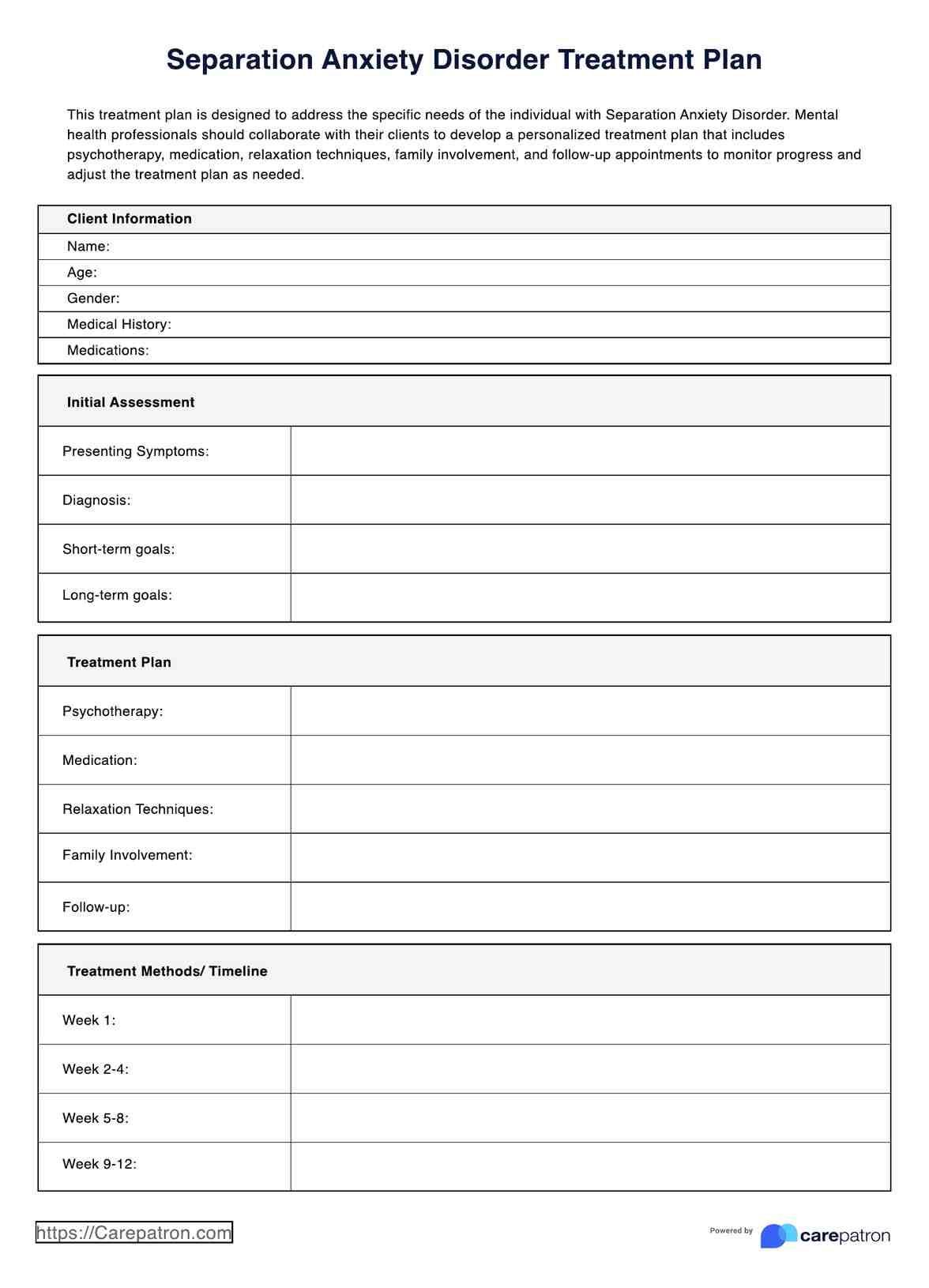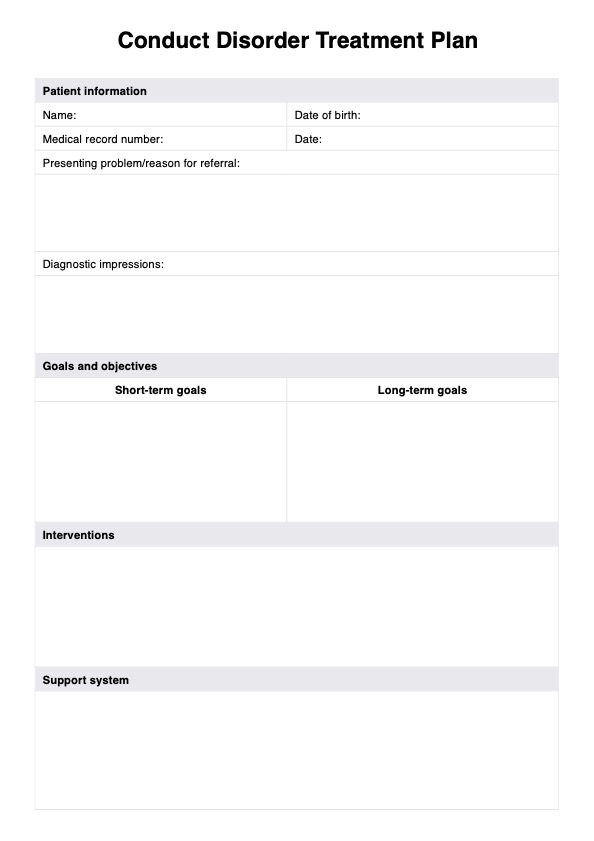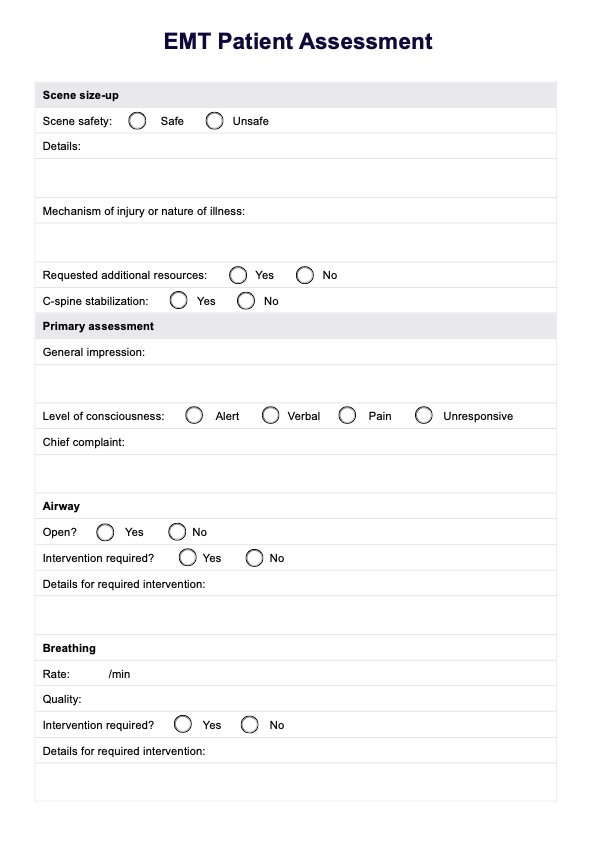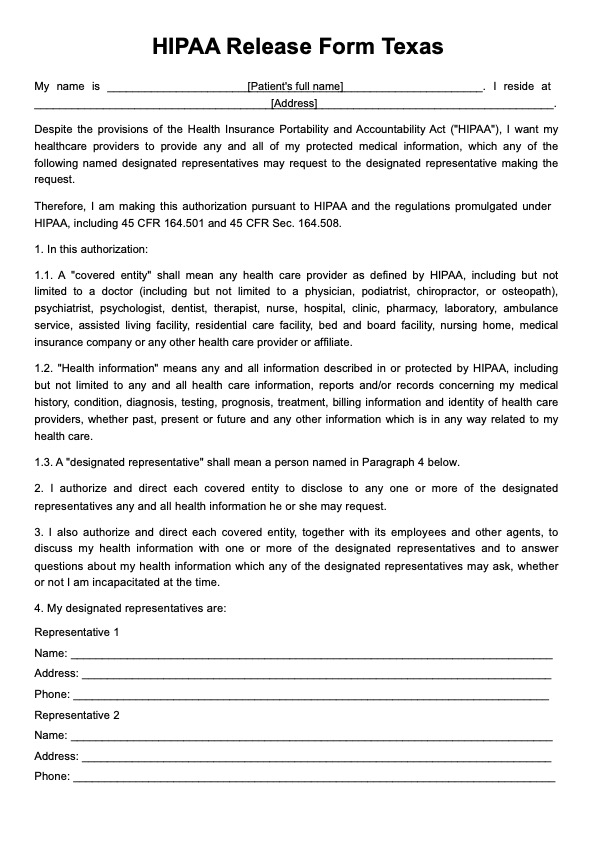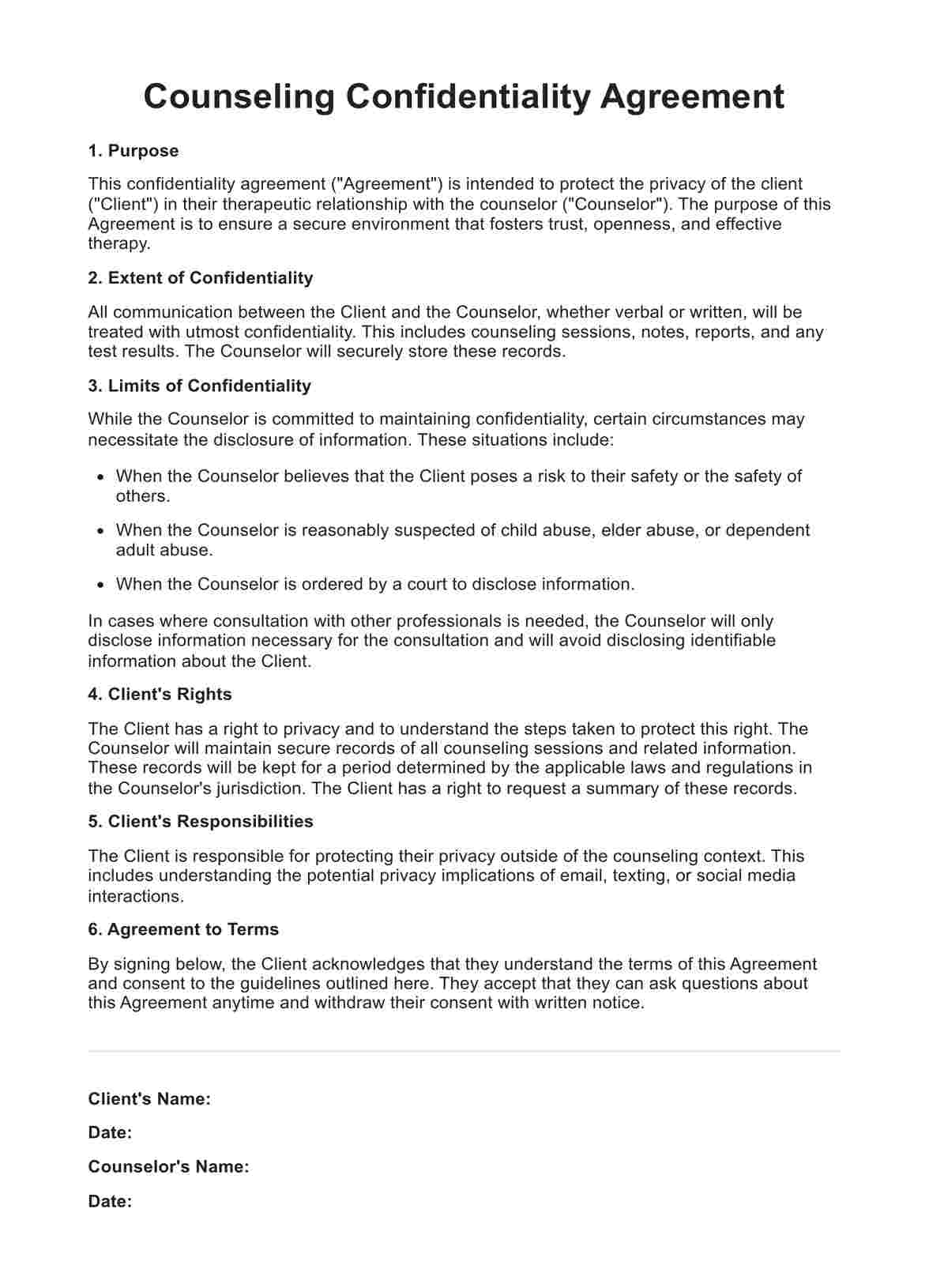PTSD Dissociation Test
Assess PTSD dissociation symptoms with Carepatron's free PDF download containing a test and examples for evaluation. Get insights and guidance on recognizing symptoms.


What is posttraumatic stress disorder?
Post-traumatic stress disorder (PTSD) is a complex mental health condition that can develop in individuals who have experienced or witnessed a traumatic event. These events may include natural disasters, military combat, terrorist attacks, serious accidents, or physical or sexual assault. PTSD can also arise from ongoing exposure to traumatic situations, such as domestic violence or childhood abuse. It's crucial to understand that not everyone who experiences a traumatic event will develop PTSD, but those who do may struggle with a range of symptoms that significantly impact their daily lives.
One hallmark of PTSD is the presence of intrusive memories, flashbacks, or nightmares related to the traumatic event. These memories can be distressing and may feel as if the individual is reliving the trauma. Other symptoms include avoidance of reminders of the trauma, negative changes in mood and thinking, and increased arousal or reactivity.
Other specified dissociative disorder experiences are also associated with PTSD. Dissociation involves a disconnection between thoughts, memories, identity, or consciousness. While dissociation is a common symptom of PTSD, it's essential to note that dissociative identity disorder (formerly known as multiple personality disorder) is a distinct diagnosis and not synonymous with PTSD.
To assess the severity of symptoms in individuals with PTSD, mental health professionals may use tools such as the Dissociative Experiences Scale (DES). This self-report questionnaire helps gauge the frequency and intensity of dissociative experiences.
PTSD is often comorbid with other mental disorders, such as depression, anxiety, and substance use disorders. Seeking treatment for PTSD is crucial for improving quality of life and reducing the risk of long-term complications.
Therapy, particularly cognitive-behavioral approaches like prolonged exposure therapy, cognitive processing therapy, and medication, can effectively alleviate symptoms and help individuals regain control over their lives. Therapies involve activities like doing daily logs of dissociation worksheets.
Early intervention and support from a licensed mental health professional are key in addressing PTSD and promoting recovery.
Symptoms and characteristics of PTSD
Post-traumatic stress disorder (PTSD) is characterized by a range of symptoms and characteristics that significantly impact an individual's well-being and daily functioning. Understanding these symptoms is crucial for accurate diagnosis and effective treatment.
Below are the key symptoms and characteristics commonly associated with PTSD:
1. Intrusive memories
Individuals with PTSD often experience intrusive memories of the traumatic event. These memories can manifest as distressing thoughts, flashbacks, or nightmares, causing significant distress and discomfort.
2. Avoidance
Avoidance behaviors are common in individuals with PTSD. They may avoid people, places, activities, or situations that remind them of the traumatic event. This avoidance can interfere with daily functioning and may lead to social isolation.
3. Negative changes in mood and thinking
PTSD can result in negative changes in mood and thinking, leading to feelings of guilt, shame, or detachment from others. Individuals may experience persistent negative beliefs about themselves or the world, along with distorted perceptions of the future.
4. Increased arousal or reactivity
Individuals with PTSD often exhibit heightened arousal or reactivity to stimuli. This can include irritability, anger outbursts, hypervigilance, difficulty concentrating, and exaggerated startle responses. These symptoms can interfere with sleep and overall well-being.
5. Dissociative symptoms
Such symptoms are common in individuals with PTSD. These symptoms involve a disconnection between thoughts, memories, identity, or consciousness. While dissociation is a hallmark of PTSD, it's essential to distinguish it from dissociative disorders such as dissociative identity disorder (DID).
6. Comorbidity with other mental health conditions
PTSD frequently coexists with other mental health problems, such as depression, anxiety disorders, and substance use disorders. The presence of comorbid conditions can complicate diagnosis and treatment, highlighting the need for comprehensive assessment and intervention.
PTSD Dissociation Test Template
PTSD Dissociation Test Example
What is a PTSD dissociative subtype?
The PTSD Dissociative Subtype is a specific classification within the realm of Post traumatic Stress Disorder (PTSD) that highlights the presence of dissociative symptoms alongside typical PTSD symptoms. Dissociation involves a disconnection between thoughts, memories, identity, or consciousness and can manifest in various ways, such as depersonalization, derealization, or dissociative amnesia.
The importance of recognizing the subtype lies in its potential implications for diagnosis, treatment, and prognosis. Individuals with this subtype may experience more severe symptoms and functional impairment compared to those without dissociative features. Therefore, identifying dissociative symptoms in individuals with PTSD is crucial for providing appropriate and tailored interventions.
One tool commonly used to assess dissociative symptoms in individuals with PTSD is the Dissociative Disorders Interview Schedule (DDIS). This structured clinical interview helps clinicians systematically evaluate dissociative experiences and distinguish between PTSD and dissociative disorders.
Understanding the subtype also sheds light on the complex interplay between trauma and dissociation. While dissociative symptoms are common in PTSD, they may represent a distinct clinical entity requiring specialized treatment approaches. Moreover, addressing dissociative symptoms in individuals with PTSD can improve overall treatment outcomes and enhance recovery.
What problems can dissociation cause if left untreated?
Dissociation, if left untreated, can lead to a range of significant problems that affect an individual's mental health, functioning, and overall well-being. Here are some potential consequences:
- Continued distress and dysfunction: Untreated dissociative symptoms can perpetuate ongoing distress and dysfunction in daily life. Individuals may struggle to manage their emotions, relationships, and responsibilities, leading to impairments in work, school, and social functioning.
- Increased risk of revictimization: Dissociation can leave individuals vulnerable to revictimization, as they may struggle to recognize and respond to potential threats or dangerous situations. This can perpetuate cycles of trauma and further compromise their safety and well-being.
- Worsening of mental health issues: Untreated dissociation can exacerbate existing mental health problems, such as depression, anxiety disorders, and posttraumatic stress disorder (PTSD). Dissociative symptoms may intensify other symptoms and complicate the course of treatment, making recovery more challenging.
- Impaired relationships: Dissociation can interfere with interpersonal relationships, as individuals may struggle to connect with others or maintain meaningful bonds. Communication difficulties, emotional detachment, and unpredictable behavior associated with dissociative symptoms can strain relationships and lead to social isolation.
- Risk of self-harm and suicidal ideation: Severe dissociative disorder symptoms, if left untreated, may increase the risk of self-harm and suicidal ideation. Feelings of hopelessness, worthlessness, and detachment from reality can escalate into crises without appropriate intervention and support.
- Long-term consequences: Chronic dissociation left untreated can have long-term impacts on an individual's psychological and physiological health. Persistent dissociative symptoms may contribute to the development of dissociative disorders or other psychiatric conditions, further complicating treatment and recovery.
How do healthcare professionals diagnose PTSD?
Diagnosing Posttraumatic Stress Disorder (PTSD) involves a comprehensive assessment by healthcare professionals to evaluate the presence and severity of symptoms. The process typically follows specific guidelines outlined in diagnostic manuals such as the Diagnostic and Statistical Manual of Mental Disorders (DSM).
Here are the key steps healthcare professionals take to diagnose PTSD:
1. Clinical interview and history taking
During the initial assessment, healthcare professionals conduct a clinical interview to gather information about the individual's past experiences, trauma history, and current symptoms. This interview provides insight into the nature and impact of the traumatic event and helps clinicians determine if PTSD criteria are met.
2. Screening for PTSD symptoms
Healthcare professionals use standardized screening tools to assess for the presence of PTSD symptoms. These screening measures may include self-report questionnaires, dissociation worksheets, or structured interviews designed to capture the full range of PTSD symptoms, including intrusive memories, avoidance, negative alterations in mood and cognition, and alterations in arousal and reactivity.
3. Diagnostic criteria evaluation
Based on the information obtained from the clinical interview and screening measures, healthcare professionals evaluate whether the individual meets the diagnostic criteria for PTSD as outlined in the DSM. The DSM criteria include specific symptom clusters and duration requirements that must be met for a diagnosis of PTSD to be made.
4. Differential diagnosis
Healthcare professionals also consider other mental health conditions that may present with symptoms similar to PTSD, such as depression, anxiety disorders, or other trauma-related disorders. Differential diagnosis involves ruling out alternative explanations for the individual's symptoms and ensuring that the clinical diagnosis accurately reflects their clinical presentation.
5. Collaboration and consultation
In some cases, healthcare professionals may collaborate with colleagues from different specialties or consult with experts in trauma and PTSD to ensure accurate diagnosis and treatment planning. Collaboration allows for a multidisciplinary approach to care and ensures that individuals receive comprehensive assessment and support.
6. Ongoing monitoring and assessment
Once a diagnosis of PTSD is made, healthcare professionals continue to monitor the individual's symptoms and treatment progress over time. Ongoing assessment helps track changes in symptoms, evaluate treatment efficacy, and adjust the treatment plan to promote recovery and well-being.
What is a DSPS PTSD Dissociation Test?
The DSPS (Dissociative Subtype of PTSD) PTSD Dissociation Test is a screening tool used to assess dissociative symptoms in individuals with PTSD, particularly those who may exhibit features of the dissociative subtype. Developed based on guidelines provided by the American Psychiatric Association, this test aims to identify dissociative experiences that may accompany PTSD symptoms.
The DSPS PTSD Dissociation Test typically consists of a series of questions or statements designed to assess the frequency and severity of dissociative symptoms. These symptoms may include depersonalization (feeling detached from oneself or one's surroundings), derealization (feeling disconnected from the external world), and dissociative amnesia (gaps in memory related to the traumatic event).
The test may also include items assessing other PTSD symptoms, such as intrusive memories, avoidance behaviors, negative alterations in mood and cognition, and heightened arousal or reactivity. By evaluating dissociative symptoms alongside traditional PTSD symptoms, the DSPS PTSD Dissociation Test provides a comprehensive assessment of trauma-related experiences.
How is the score calculated?
The scoring process for the DSPS (Dissociative Subtype of PTSD) PTSD Dissociation Test involves several steps to accurately assess dissociative symptoms in individuals with Posttraumatic Stress Disorder (PTSD). Here's a breakdown of how the score is calculated:
- Endorsement and denial of symptoms:some text
- If a participant did not endorse a given lifetime symptom, the associated items (b-e) are set to 0.
- If a participant endorsed a lifetime symptom but denies it occurred in the past month, the past-month rating scales are set to 0.
- If symptoms were reported to occur only while under the influence of substances affecting consciousness, all responses are set to 0.
- Subscales:some text
- The DSPS contains three subscales:some text
- Derealization/Depersonalization (Items 1, 3, 5, 7, 8, 9, 12)
- Loss of Awareness (Items 2, 4, 6, 10, 11, 13)
- Psychogenic Amnesia (Items 14, 15)
- The DSPS contains three subscales:some text
- Scoring of lifetime subscales:some text
- Calculate the sum of the lifetime items for each subscale (a) using the identified item numbers.
- Scoring of current subscales:some text
- Sum each item's current frequency and intensity scores (c and d, respectively).
- Calculate the total summary score across items for each subscale using the identified item numbers.
- Count the presence or absence of each symptom on a given subscale, with presence defined by a frequency score of at least 1 ("once or twice") and an intensity score of at least 3 ("moderately strong").
What are the next steps after gathering results?
After gathering the results of the DSPS (Dissociative Subtype of PTSD) PTSD Dissociation Test, healthcare professionals typically proceed with several key steps to address the findings and provide appropriate support and intervention.
Below are the next steps commonly taken after results have been gathered:
- Interpretation of results: Healthcare professionals carefully interpret the results of the DSPS PTSD Dissociation Test, taking into account the severity and nature of dissociative symptoms reported by the individual. This interpretation helps guide subsequent treatment planning and intervention strategies.
- Formulation of treatment plan: Based on the results of the test and the individual's overall clinical presentation, healthcare professionals develop a tailored treatment plan to address PTSD symptoms and associated dissociative experiences. This may involve a combination of psychotherapy, medication management, and adjunctive therapies to support the individual's recovery.
- Psychoeducation and counseling: Healthcare professionals provide psychoeducation to the individual and their support network about PTSD, dissociation, and the importance of treatment. Counseling sessions may focus on helping the individual understand their symptoms, develop coping strategies, and learn skills to manage distressing experiences more effectively.
- Referral to specialized services: In cases where dissociative symptoms are severe or complex, healthcare professionals may refer the individual to specialized services such as trauma-focused therapy, dissociative disorder treatment programs, or consultation with experts in dissociation and trauma. Accessing specialized care can provide individuals with the additional support and expertise needed to address their unique needs.
- Monitoring and follow-up: Healthcare professionals monitor the individual's progress closely throughout treatment, conducting regular assessments to track changes in symptoms, functioning, and overall well-being. Follow-up appointments allow for ongoing support, adjustment of treatment strategies as needed, and reinforcement of coping skills learned in therapy.
Benefits of this test
Using the PTSD dissociation test can come with a lot of advantages for the mental well-being of the individual taking it. Here are some benefits to weigh:
Early identification of dissociative symptoms
The DSPS PTSD Dissociation Test enables early identification of dissociative symptoms in individuals with PTSD, allowing for timely intervention and support.
Tailored treatment planning
By assessing dissociative symptoms alongside PTSD symptoms, healthcare professionals can develop personalized treatment plans that address the specific needs of each individual, leading to more effective outcomes.
Enhanced clinical understanding
This test provides healthcare professionals with a comprehensive understanding of the severity and nature of dissociative experiences, informing clinical decision-making and treatment strategies.
Improved patient engagement
The use of standardized screening tools like the DSPS PTSD Dissociation Test can enhance patient engagement and collaboration in the treatment process, fostering a sense of empowerment and ownership over one's mental health.
Monitoring treatment progress
Regular administration of the test allows for ongoing monitoring of dissociative symptoms and treatment progress, enabling adjustments to the treatment plan as needed to optimize outcomes.
Treatment of PTSD
PTSD is a complex condition that can profoundly affect an individual's mental and emotional well-being. Fortunately, there are various effective treatments available to help individuals manage and overcome the symptoms of PTSD.
Psychotherapy
Psychotherapy, particularly evidence-based approaches such as cognitive-behavioral therapy (CBT) and eye movement desensitization and reprocessing (EMDR), is highly effective in treating PTSD. These therapies help individuals process traumatic experiences, challenge negative thoughts and beliefs, and develop coping skills to manage symptoms.
Medication
Medications such as selective serotonin reuptake inhibitors (SSRIs) and serotonin-norepinephrine reuptake inhibitors (SNRIs) may be prescribed to alleviate symptoms of PTSD, particularly depression, anxiety, and intrusive thoughts. Medication is often used in conjunction with psychotherapy for comprehensive treatment.
Self-help strategies
Self-help strategies, including stress management techniques, relaxation exercises, and mindfulness practices, can complement formal treatment and empower individuals to manage their symptoms daily.
Support groups
Participating in support groups or peer-led programs allows individuals with PTSD to connect with others who have similar experiences, share coping strategies, and receive emotional support in a supportive and understanding environment.
Alternative therapies
Some individuals may find relief from PTSD symptoms through alternative therapies such as yoga, acupuncture, art therapy, or animal-assisted therapy. While these approaches may not be considered primary treatments, they can be beneficial as adjunctive interventions.
You can also use this PTSD Treatment Plan template to outline and track your client's progress and treatment goals. This template facilitates detailed planning and documentation, enhancing the overall treatment process.
Commonly asked questions
Other tools for assessing dissociation include the Dissociative Experiences Scale (DES), the Structured Clinical Interview for DSM-Dissociative Disorders (SCID-D), and the Clinician-Administered Dissociative States Scale (CADSS).
The four dissociation stages are amnesia, depersonalization, derealization, and identity confusion.
You may be dissociating if you feel disconnected from your thoughts, emotions, or surroundings, experience memory lapses, or feel as though you are observing yourself from outside your body.


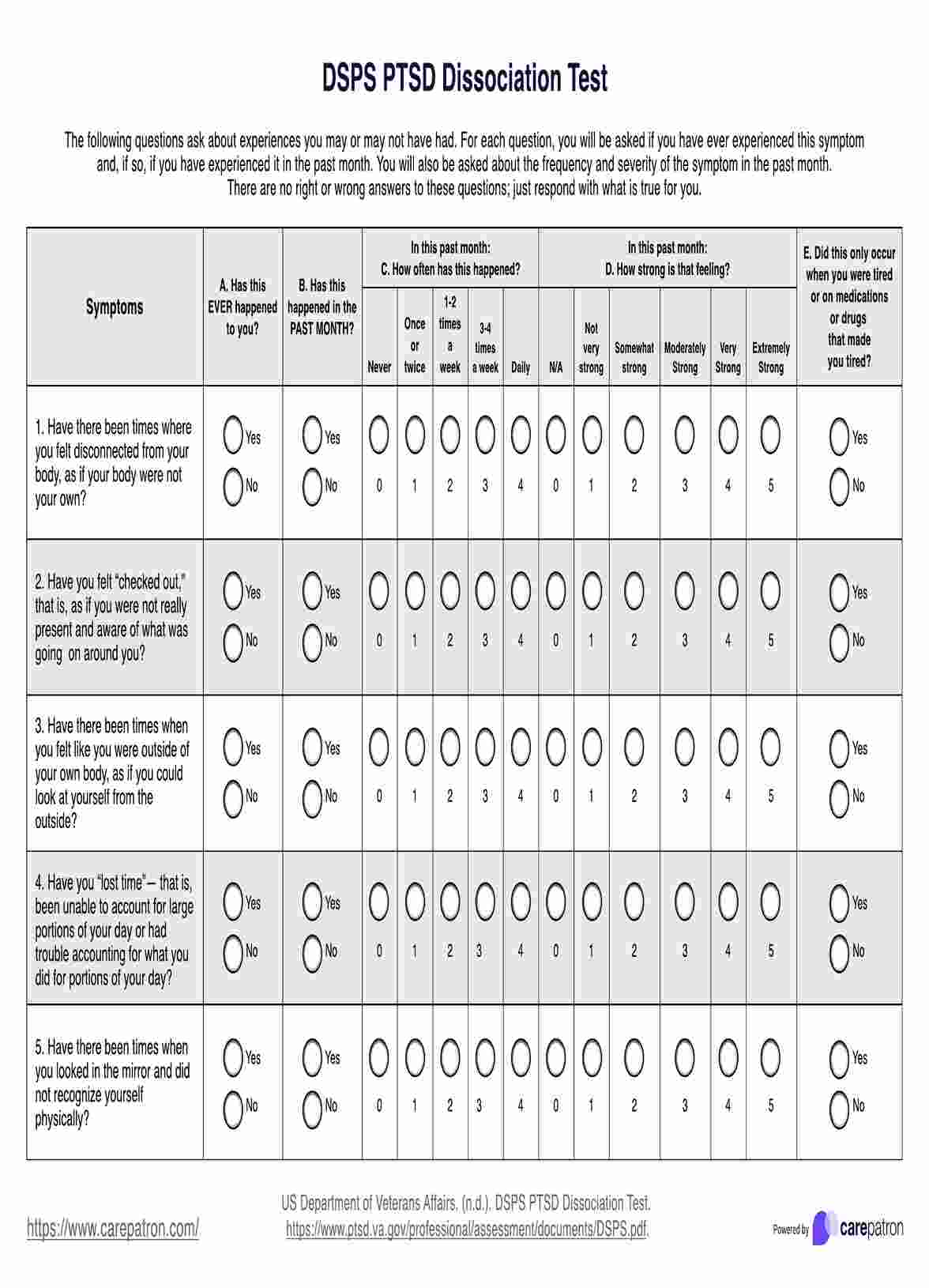
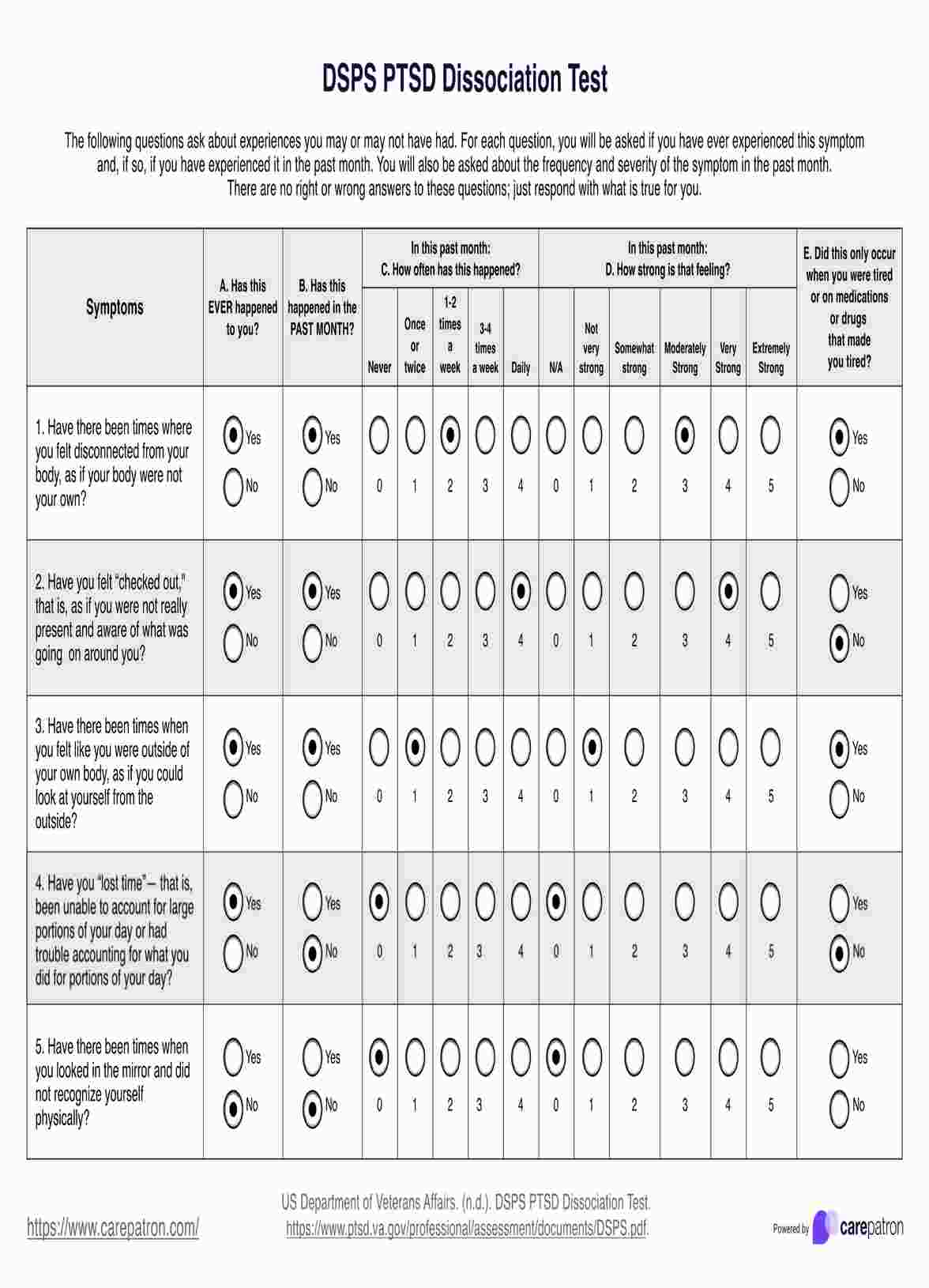

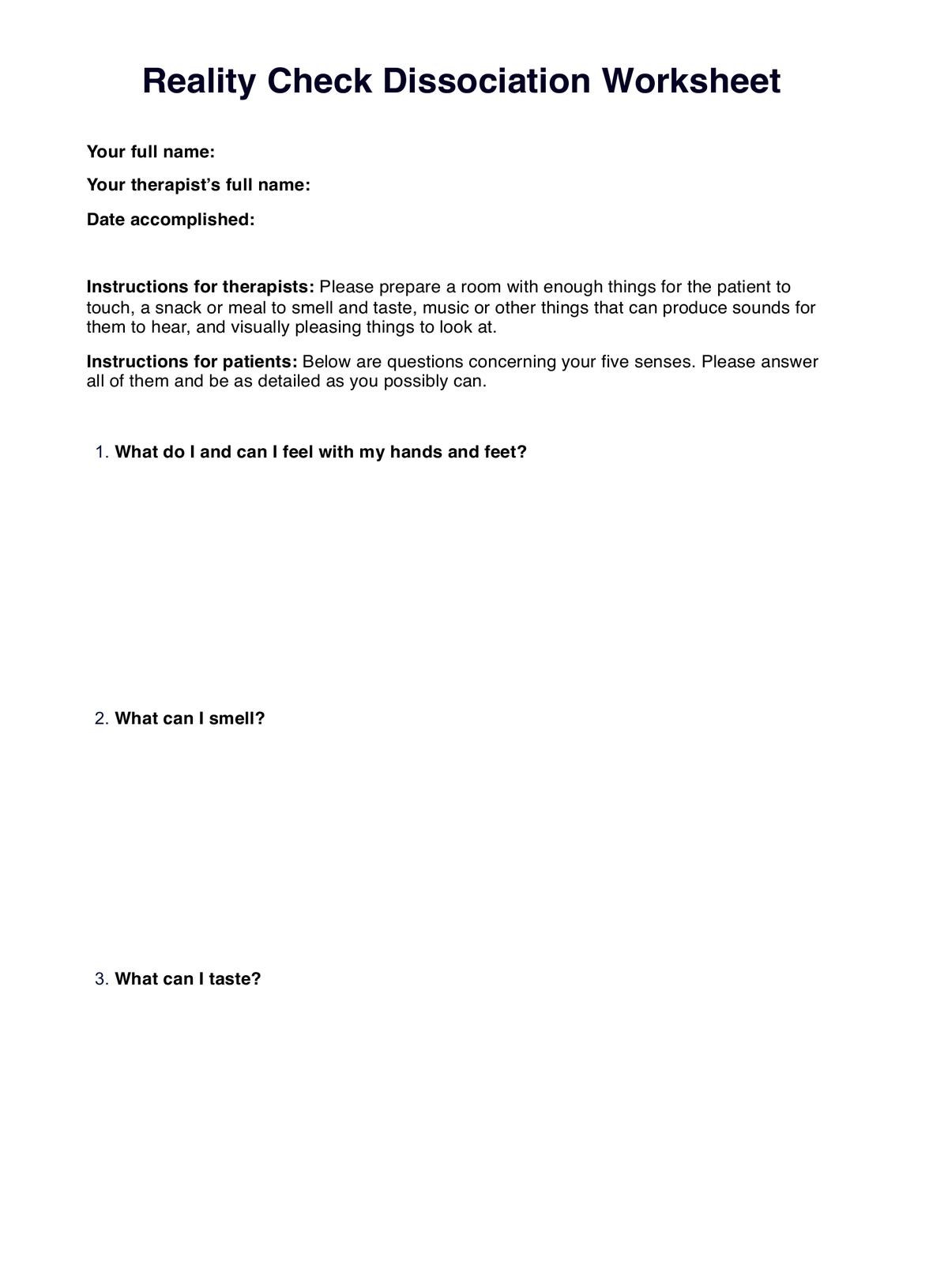




















-template.jpg)
















































































